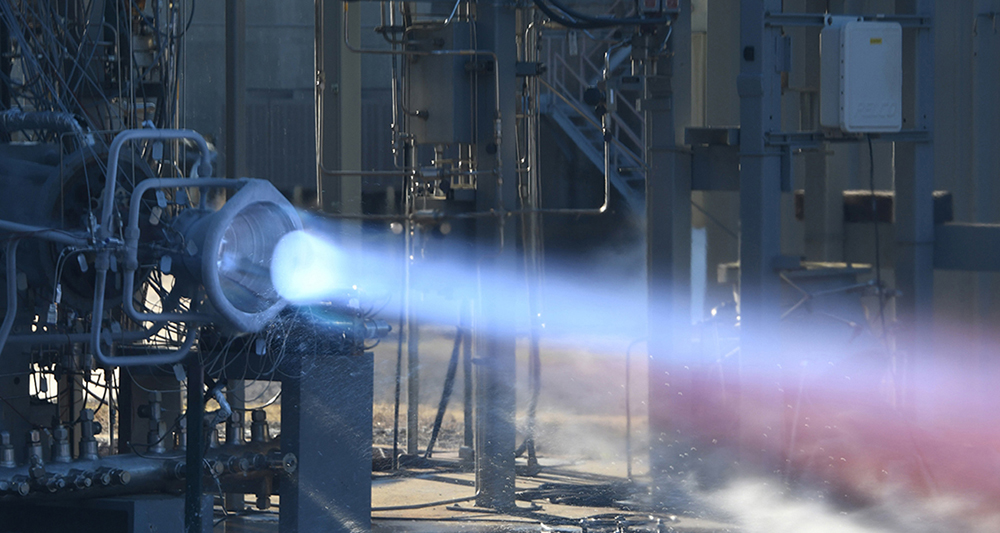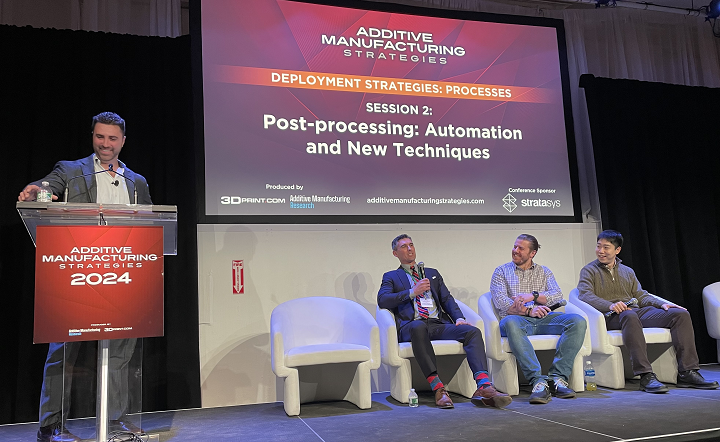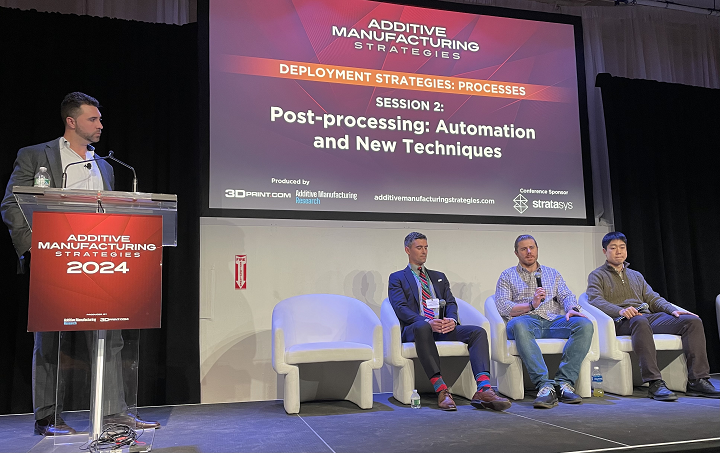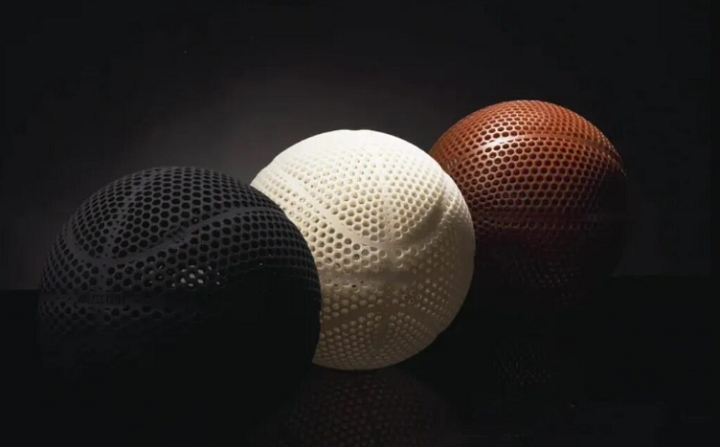We’ve come a long way in thinking of post-processing as the (only?) dirty little secret of the AM industry, and trying to hide how much work it can actually be to finish a print, but we’re not completely out of the woods yet. I remember talking with someone at formnext about how it would be more helpful, and truthful, to indicate which parts on display were just off the print bed, and which ones had gone through post-processing, so newcomers wouldn’t get the wrong idea. For the purposes of mainstream AM adoption, it is essential that people realize that post-processing and finishing are an integral part of the workflow, which is why the “Post-Processing: State of the Art” panel at our recent Additive Manufacturing Strategies (AMS) 2024 business and networking summit was a great addition to the program.
$145M Per Year
Moderator Ryan Hayford, the Founder of Hayford Consulting, cited the 2022 “Post-Processing for Additive Manufacturing: Market Analysis and Forecast” report by AM Research, which suggested that the polymer post-processing industry brings in more than $145 million per year, most of which is related to automotive and aerospace applications. Noting their varied disciplines in the AM industry, Hayford asked the panelists if they were seeing the same trends in those same markets, or if there were other markets that had “high adoption usage with post-processing.”
Justin Michaud, CEO of REM Surface Engineering, said that while last year he would have disagreed with aerospace, he’s seen a recent shift in that sector, moving away from “some of the more accessible geometries into applications like heat exchangers,” where fluid flow dynamics are more important. He also noted that there’s been lots of growth in space applications, and “based upon that recent experience, I would tend to agree with it, and we do think that’s probably the place that we’ll see the most activity in the next year or so.”

Hot fire test of a nozzle 3D printed from NASA-developed superalloy metal. The nozzle’s surface was polished by REM Surface Engineering. Image courtesy of NASA
Mike Schorr, General Manager, DyeMansion North America, noted that his company has traditionally worked in the automotive space, which has more recently “transitioned to actual end-use products.”
“But more importantly, I think the medical space is actually our largest growing sector right now,” he continued. “It’s really picking up steam, primarily because the funding is really behind it, and surface finish is really key to the application. Not too far behind this is aerospace, but I’d say it’s got a little ways to move, especially on the polymer end.”
ARIS Technology CEO Mingu Kang said he sees a lot of demand for hybrid manufacturing, and thus post-processing, in defense applications, noting that “we have to sometimes link what’s currently feasible in additive and what’s not, and post-processing can become a bottleneck or an opportunity for the defense industry.”
“So a lot of times if you can’t actually take a process right now that is really not feasible by current work orders or current processes and et cetera, and if you want to bring that into the process and say, ‘Hey, I can automate the entire workflow from here to there, that’s, I think, the opportunity we’re seeing,” he continued. “And I think with the advancements in intelligence of this automation, it’s also becoming more critical in the defense industry.”
Outside AM
Hayford asked Kang and Michaud, who aren’t initially from the AM world, what other manufacturing industries require for post-processing, “or something that we need to be aware of in the additive market?” Kang said that a general trend is designing “more creatively versatile” and customized products “as the paradigm has shifted” and manufacturing models must change.
“I believe the expectation is that once you make something, you want to sustain it better, or you may have to make it a lot more cost effectively,” Kang said.
Toolmakers and aircraft manufacturers will say that they’ve made something, and need to sustain it for a certain number of years, and want to know how additive can help them do that, but Kang noted that there’s missing data and knowledge, as well as workforce and supply chain support, in answering them.
“Technological sustainment is a very good target, but from the requirement point of view, is it really ready?”

L-R: Ryan Hayford, Hayford Consulting; Justin Michaud, REM Surface Engineering; Mike Schorr, DyeMansion NA; Mingu Kang, ARIS Technology.
Michaud said that even though his company has been around for nearly 60 years, post-processing can sometimes still be considered somewhat of a new thing.
“A challenge we’ll get, less frequently now, but certainly it still happens, is a customer will come to us with a challenge to solve on the surface finishing side, to address some issue there, but they haven’t considered post-processing in the design space,” he said. “Perhaps with the part design, I think the complex applications are the right ones, but they often come as a challenge on the processing side. That was similar to when we were first breaking into the gear industry, as an example, that’s a big part of our business. Often there was not a lot of consideration for this additional operation step happening after final grinding. But that’s changed now.”
This is what’s needed in manufacturing: to think about the end step of post-processing during initial part design, instead of trying to panic-fix it at the end.
Addressing Problems in Printing
Hayford said that many in the industry have noted that the length of time to finish parts, and the lack of consistency, are key challenges, and asked the panelists how they, “as hardware, software, and service providers,” would address those challenges. Michaud said that REM’s process is tailored to fit the needs of customers, and not just “a stock recipe” or a “drop-in solution.” This unfortunately does add time to the overall project, especially if the application is more complex. But, I ask you, isn’t it better to have the design and end product exactly the way you want?
“But once you actually go to the production side, I think production’s pretty quick,” Michaud continued. “I think in general, you know, we’re gonna beat most additive printing processes from a time perspective…We see customers come in and they’re saying, ‘Hey, this [post-processing] is taking you 30% of our overall time.’ Well, it can get simpler, but typically that’s gonna involve some development, and it’s just not something that’s always considered early on.
He said that it all comes down to planning and budgeting for post-processing to be part of the overall part processes. Schorr completely agreed with Michaud’s point of view.
“One of the first couple of questions you ever ask a customer is, what do you actually want the part to do? What does it need to do? What is it required to do? Are there certifications involved that generally elongate the entire process? That can also define what surface finishes are required at the end of the day, or what post-processing technique or what material needs to be used,” he said.
He noted that DyeMansion has different ways to track repeatability from system to system, which helps to ensure consistency, and that the company also puts a lot of effort into traceability; this way, if there’s an issue once the product is completed, they can go back and discover where the problem started, “or at least trace the initial resources put into it.”
Kang said that ARIS sees many clients who use AM for prototyping or production ramp-up, and not mass production, and that in-situ information is key to ensuring consistency and repeatability.
“You may assume you’re making something right from the metrology point of view, we deal with that all of the time. But when you make the part, when it cools down in a certain environment, certain temperature, it may change, right? It may be different from what you expect,” he said. “Lots of manufacturers are already embedding in-situ monitoring, but do we have enough localization data to link it to final qualification or certification or quality data for this particular part? So we struggle through that process right now. I think the communication is still missing, and we don’t have an open source community to really talk about this and fight for something that’s standardized.”
Improving Part Performance with Post-processing
When asked whether they believe you can increase the performance of a part with post-processing, each panelist answered a quick “yes,” which makes sense. Then Hayford asked them to give a tangible example “of when post-processing is beneficial to the performance of the part.” Michaud said that many aerospace opportunities are fluid flow applications, and said that challenges can arise from granular surfaces and laser powder bed fusion, which makes it hard to conform to existing standards. But with the application he was discussing, they’re not forcing heavy abrasives through internal channels, because REM uses “a pure chemical approach.”
“We’re able to really remediate a lot of the powder that’s in there that could create a challenge from a failure perspective,” he said. “So that’s a situation where I think you’re maximizing a lot of value of additive.”
Schorr explained that a simple polymer part, even a really good one, is still porous, and will absorb everything from blood and sweat to skin. So he said that vapor fusing can definitely enhance the material properties of a part, “whether it be a transport tube of a certain chemical, an automotive application, or an air transfer tube, like ventilation for aerospace applications,” and even parts used in the operating room that have to be washed. He also said that with any smoothing process, solvent is being added into the vapor form, which creates condensation on the part and “now we could enhance the performance characteristics of something like a footwear application.”
“But more importantly, some of you probably saw the basketball that was around this past year,” Schorr said, referring to the 3D printed Wilson Airless Gen1. “It was a very big project application for us, not just because of the marketing appeal to it, but it was specific because the ceiling of it had to meet a specific hand-feel texture and be very durable. So it actually went through the same exact, if not harder specifications as a traditional ball. And if it was not vapor fused, it failed every time. So the solvent actually enhanced the properties.”
Q&A
A great audience question centered around the medical vertical, and what other areas within the sector post-processing can help with in enhancing beyond the prototyping phase. Schorr again mentioned how smoothing makes a part washable for use in the OR. But another example was patient-specific prosthetics and orthotics, which can be customized during finishing to match a person’s skin tone, or just their favorite color. However, the most important aspect is biocompatibility in the customization, since these types of products are often directly touching skin, and post-processing solutions can help with this as well.
“It has sweat, hair particles, it’s gonna get food and all these other sorts of things on it,” Schorr said. “Can you wash it? Is it safe to touch the patient?”
Another audience member asked why post-processing is often an afterthought in developing parts, and how we can help change this view.
“I think for a lot of years, there was this idea that you hit print, the part came out and was ready to go,” Michaud said, referencing our industry’s former spot at the Peak of Inflated Expectation on the Gartner Hype Cycle. “I think we overcome that by situations like this [AMS], sharing information and case studies and talking about things. And also, I think you bring more experience into the AM space that maybe didn’t start on this side, right? I mean, your traditional manufacturing folks know that you don’t make a gear in one shot—there’s a lot of different operation steps, and post-process is an operation step. Certainly you don’t add operation steps if you don’t need them, but for the applications when you do, it needs to be considered early in the process.”
As Hayford wrote in a post-AMS LinkedIn post, we in the industry can help improve AM adoption by addressing post-processing strengths and weaknesses earlier in the manufacturing process, rather than treating finishing technologies as an afterthought. That won’t do us any favors.
Subscribe to Our Email Newsletter
Stay up-to-date on all the latest news from the 3D printing industry and receive information and offers from third party vendors.
You May Also Like
Gorilla Sports GE’s First 3D Printed Titanium Cast
How do you help a gorilla with a broken arm? Sounds like the start of a bad joke a zookeeper might tell, but it’s an actual dilemma recently faced by...
Nylon 3D Printed Parts Made More Functional with Coatings & Colors
Parts 3D printed from polyamide (PA, Nylon) 12 using powder bed fusion (PBF) are a mainstay in the additive manufacturing (AM) industry. While post-finishing processes have improved the porosity of...
$25M to Back Sintavia’s Largest Expansion of Metal 3D Printing Capacity Since 2019
Sintavia, the digital manufacturing company specializing in mission-critical parts for strategic sectors, announced a $25 million investment to increase its production capacity, the largest expansion to its operations since 2019....
Velo3D Initiates Public Offering in a Bid to Strengthen Financial Foundations and Drive Future Growth
Velo3D (NYSE: VLD) has been among a number of publicly traded 3D printing firms that have attempted to weather the current macroeconomic climate. After posting a challenging financial report for 2023,...



































